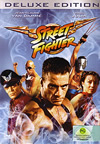|
 Hollywood
never ran out of ideas. Original ones perhaps but the
studios, be it the major few or the independent labels
always have outlets to turn to when it comes to movie
scripts. One obvious source - the lucrative video games
market. Hollywood
never ran out of ideas. Original ones perhaps but the
studios, be it the major few or the independent labels
always have outlets to turn to when it comes to movie
scripts. One obvious source - the lucrative video games
market.
THE PLUMBERS WHO STARTED IT ALL
In 1993, the now defunct Cinergi Pictures and Nintendo
came up with a live-action version of the “Super
Mario Bros”. The Mario Bros were huge in those
days, just try asking anyone around you who were born
in the late seventies and eighties. But the movie turns
out to be nothing like the video game counterpart. Sets
were gloomy, story was dull, a huge difference from
the colourful Nintendo graphics even though veterans
such as Bob Hoskins and Dennis Hopper tried to live
up to the absurdness.
 Capcom
Entertainment joined in the race with “Street
Fighter the Movie” the following year. Street
Fighter the video game brought huge profits to the renowned
Japanese game developer and characters such as Ryu,
Chun-Li, Guile became the idol of many youths worldwide.
Writer and Director Steven de Souza attempted the live-action
with then leading action man, Jean-Claude Van Damme
as Guile. Again it was another huge disappointment to
the fans. Ironically, HK director Wong Jing’s
own ‘unlicensed’ version of Street Fighter
called “Future Cops” had a bigger cult following
in Asia with its ensemble cast of A-list HK stars and
wild action choreography which fared closer to the video
games. Capcom
Entertainment joined in the race with “Street
Fighter the Movie” the following year. Street
Fighter the video game brought huge profits to the renowned
Japanese game developer and characters such as Ryu,
Chun-Li, Guile became the idol of many youths worldwide.
Writer and Director Steven de Souza attempted the live-action
with then leading action man, Jean-Claude Van Damme
as Guile. Again it was another huge disappointment to
the fans. Ironically, HK director Wong Jing’s
own ‘unlicensed’ version of Street Fighter
called “Future Cops” had a bigger cult following
in Asia with its ensemble cast of A-list HK stars and
wild action choreography which fared closer to the video
games.
ONE HIT THE JACKPOT
You
want more cheese to go with your nachos and game console?
There you have it. In 1995, Paul W.S. Anderson brought
“Mortal Kombat”, the America’s answer
to Street Fighter to the big screen with the help of
New Line. Avoiding the mistakes made in SF, Anderson
went all out in the martial-arts department with CG
enhancement effects. In the end, “Mortal Kombat”
made three times the amount in the box-office domestically
on a shoestring budget of US$20 million. Two years later
however, the sequel “Mortal Kombat: Annihilation”
bombed spectacularly with only a measly US$51 million
combined receipts while the first grossed US$122 million
at the end of its run.
Ideas
never die and the bunch of valor studio executives and
filmmakers revive the crazy wave of video games adaptations
in June 2001 with Edios Interactive and Paramount’s
“Lara Croft: Tomb Raider”. The English female
archaeologist with a svelte figure of a devil played
by the now Mrs Pitt aka Angelina Jolie made over US$300
million although panned heavily by critics. A month
later, Columbia Pictures ambitiously released the photorealistic
(mind you this was way before the release of the much
successful “The Polar Express” and “Beowulf”)
3D animated feature, “Final Fantasy: The Spirits
Within” based on the role-playing games. It bombed
big time despite Sony’s aggressive marketing and
apparently caused the electronics conglomerate to lose
at least US$50 million.
TO INFINITY AND BEYOND
 The
man who miraculously made a difference in the genre,
Mr Paul W.S. Anderson direct and wrote The
man who miraculously made a difference in the genre,
Mr Paul W.S. Anderson direct and wrote  another Capcom
based shooter game “Resident Evil” in 2002
with his current beau, model Milla Jovovich as Alice,
a heroine who tried to escape an underground science
facility which is populated with zombies. Anderson hit
the jackpot with box-office of over US$100 million for
Screen Gems. Since then it has successfully spawned
two sequels “Resident Apocalypse” and “Resident
Extinction”. The fourth is supposedly in the pipeline.
One must note that all three were made on a relatively
low budget as compared to a standard Hollywood production
which could skyrocket to as much as US$1oo million (marketing
costs including). With an average budget of less than
US$50 million each, the RE series easily raked in three
times the amount for every sequel. You do the maths. another Capcom
based shooter game “Resident Evil” in 2002
with his current beau, model Milla Jovovich as Alice,
a heroine who tried to escape an underground science
facility which is populated with zombies. Anderson hit
the jackpot with box-office of over US$100 million for
Screen Gems. Since then it has successfully spawned
two sequels “Resident Apocalypse” and “Resident
Extinction”. The fourth is supposedly in the pipeline.
One must note that all three were made on a relatively
low budget as compared to a standard Hollywood production
which could skyrocket to as much as US$1oo million (marketing
costs including). With an average budget of less than
US$50 million each, the RE series easily raked in three
times the amount for every sequel. You do the maths.
Continue to Part Two >
|
 Hollywood
never ran out of ideas. Original ones perhaps but the
studios, be it the major few or the independent labels
always have outlets to turn to when it comes to movie
scripts. One obvious source - the lucrative video games
market.
Hollywood
never ran out of ideas. Original ones perhaps but the
studios, be it the major few or the independent labels
always have outlets to turn to when it comes to movie
scripts. One obvious source - the lucrative video games
market. 

